PART 3: 1985-1987

This is the first amateur cooled array CCD camera, mounted on the 24" telescope on Pic du Midi in June 1985. The rear of the camera has been reduced to the enormous profile of the radiator fins for the power supply circuits. The large fan completes the arrangement for evacuating heat. The CCD is quite simple, in the open air, a thick block of glass mounted on the entrance aperture to prevent frosting, with a film of oil between the two to suppress interference fringes caused by unequal thickness. A black cloth covered the camera while observing. The whole thing relied on an Apple IIe located in a nearby laboratory.
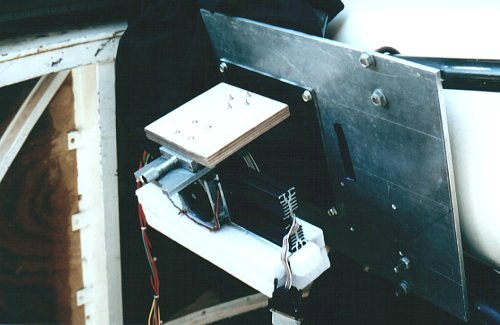
For this first camera cooling was performed by a polyurethane structure in contact with the radiator which was filled with spoonfuls of dry ice (carbonic ice). At that point the temperature of the CCD fell temporarily to -112° F.! It only worked for a few minutes, just long enough to make one image. To make the dry ice, we depended on enormous bottles of carbon dioxide gas in a canvas bag. One of our preoccupations in those days was that of manhandling our stock of 5 foot tall gas bottles, which could be moved only by two people in good physical condition!

The camera’s electronics were then rearranged onto a computer card, which was plugged into one of the Apple IIe’s expansion ports. The printed circuit board was etched by hand. Digitization was increased to 10 bits. A quartz oscillator, which you can see at top left, served as a fast clock chip for clearing the horizontal register of the CCD chip very quickly.

This was our setup in the lab next door to the 24” telescope. There was a mountain of instruments to maintain, including, among others, three Peltier modules. The TV in the foreground was used to display images in 8 colors – and also to watch soccer matches! We were in the habit of going to the Pic du Midi at the end of June, a time of year full of major sporting events (European and World soccer cups). During our CCD exposures we avidly followed France’s victory in the 1984 European Cup, and two World Cups! In those days we used the ‘M.A.T.’ computer program for image acquisition with a matrix array CCD, and the ‘T.I.’ program for image processing, all in assembly langage. Ascending the Pic du Midi with all that equipment – and don’t forget the enormous bottles for making dry ice! – made it a veritable expedition.

This is the first object observed by CCD using the 24” telescope on 15 June 1985: M104, the ‘Sombrero Galaxy.’ At that point we had only a very vague idea of the CCD’s possibilities, so when this image appeared on the computer, although it is quite modest by the standards of observers today, it unleashed an extraordinary ovation in the 24” telescope laboratory. That remains a very vivid memory. Realize, in a two minute exposure it was possible to see the band of dust circling that edge-on galaxy! However, one can also recognize in this artifact of that time the problems of graphic display, as well as the difficulty of accurately pointing a telescope with such a small field of view. That amateur expedition to Pic du Midi, which ran from 15 to 25 June1985, is certainly the most moving that I can recall. My companions on that expedition and during the infancy of CCD technology were Serge Chevrel, Jean-Claude Francoual, Eric Thouvenot, Bernard Marlière, Richard Szczepaniak and Olivier Zuntini. You can find an article on this expedition in Ciel et Espace magazine, volume 211, May-June 1986.

At the beginning of 1986, in a frenzy of urgency, a camera based on the Thomson TH7852 CCD chip was built to observe Comet Halley from the island of Réunion. Once again we camped out in the mechanical workshop of the Toulouse Superior School of Aeronautics; Richard Szczepaniak and Eric Thouvenot were the heroes there. Out budget forced us to build a camera that was relatively easy to use, and that could be reasonably transported to the other side of the Earth. Construction did not proceed without casualties, as this picture shows. An error on the mechanical side caused the CCD chip to be crushed during the first closing of the housing!

In April 1986 Comet Halley was observed with this camera from the island of Réunion. It was used in conjunction with lenses ranging from 50mm to 300mm in focal length, all of which were mounted on a special equatorial mount. This made it a big and heavy expedition. The camera was completed just in time, and certainly I still recall some epic searches we were forced to make on that island for a soldering iron or an oscilloscope. A vacuum was created inside the housing, which explains the thickening of the walls (which are a little overbuilt), and overbuilt mounting brackets which permit the device to be adapted to standard amateur telescopes.
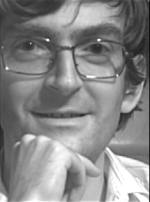
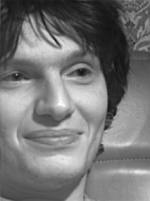

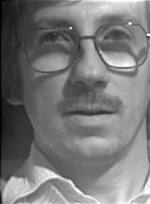
Actor of CCD astronomy in Toulouse at the date of 12 February 1986. From left to right : Christian Buil, Eric Thouvenot, Guylaine Prat, Serge Chevrel. This images are the first made with the TH7852 Halley CCD camera.


The instrumentation in action at the Réunion island (Dos d'Ane region). Notice the big floppy disk of the computer...

This is one of the numerous CCD images of Comet Halley obtained from the island of Réunion. Extremely short focal lengths were required, because even at those focal lengths the comet still took up the entire field of view in the small images of those days. Here you see an attempt to subtract the numerous stellar images from the field, Halley then being right in the middle of the Milky Way. The image processing program was called ‘T.I.4’. It used a command-line interface. It was a little rough, but incredibly effective when one had mastered the beast. One can already find in that program that which makes for good photometry and astrometry.

In December 1986, the camera that handled Halley was mounted on the Pic du Midi 40” telescope. This was the first time that an area array CCD camera was used on this telescope. For that occasion, the radiator fins were modified to further improve the cooling system’s efficiency (the brightest parts on the top and bottom of the camera). A bracket for a swinging target recovery mirror is mounted in front of the camera to facilitate pointing. The camera’s mounting is primitive, wooden boards and thin metal rods. The main electronics case for the camera is mounted beneath the wooden board. In that month of December 1996, Eric Thouvenot and I had the extraordinary privilege of doing CCD astronomy with a giant telescope – an opportunity unimaginable for amateurs. Our targets were planetary nebulae, the triple quasar, and Jupiter…

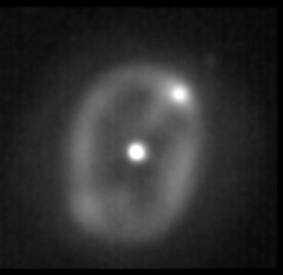
First deep sky image made at the one meter telescope of the Pic du Midi in December 1986. This is the planetary nebulae NGC2022. The image at right is in the original format (96x96 pixels - remember the low memory capacity of Apple II !). A zoom is visible at left.
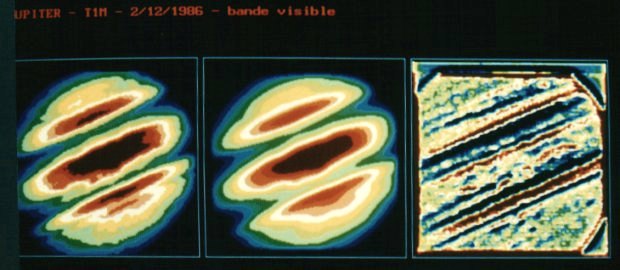
These are the first images of Jupiter obtained with a matrix array CCD camera on the Pic du Midi 40” telescope (one meter telescope), in December 1986. This picture also displays the technique of ‘unsharp masking’, once again not quite fully matured. The Apple IIe is always in the dome, and it is absolutely freezing throughout the long beautiful nights. This was the last expedition we made alone, as amateurs, with the 40” telescope at Pic du Midi. The following year, Jean Lecacheux and Francois Colas recognized the potential of CCD technology while observing the planets with the 40”, and thereafter we embarked upon some very fruitful amateur-professional collaborations…


The month of August 1987 marked an important step. I built the first camera on a human scale, small enough to be installed on a small amateur telescope, and not just the 24” or 40” telescopes on the Pic du Midi. The CCD chip I used was the Thomson TH7852. In that month of August 1987, Eric Thouvenot, Guylène Prat, Olivier Gadal (the telescope’s owner) and I, all rediscovered the incredible possibilities of the CCD for amateur astronomers. This CCD camera is quite characteristic of that era, a real gas guzzler (vacuum pump, water pump…). The joint used to preserve the vacuum in the CCD’s housing, which you can see behind the CCD, was made from an automobile tire inner tube, salvaged not far from our observing site in the Limoux Hills, in the French province of Aude. It was at that time that the idea was born to devour every celestial object and to assemble what would become the Buil-Thouvenot Atlas.

Also in 1987, the performance of PC-compatible computers finally surpassed that of the venerable Apple IIe, which by then was out of breath, and was put out to pasture. Progress in CCD technology is closely tied to progress in Information Technology! These two images were taken with the Pic du Midi 40” in October 1987. They were selected to illustrate the 1988 postcards of the Midi-Pyrénées Observatory, the result being called the fruit of amateur-professional collaboration. François Colas, Jean Lecacheux, Pierre Lacques, Christian Buil and Eric Thouvenot were at the controls. These were our first tentative steps in the realm of color imaging, and progress is evident in the techniques of image acquisition and image processing. On the left, Jupiter in methane band of 8930Å; on the right, Jupiter observed in the spectral continuum around 8000Å, both in the near-infrared. The camera was the same as the one mounted on the Vixen telescope in the preceding photo. That camera would also have a long career, as it was used by the group as the detector in the spectrograph for the 24” telescope. In order to obtain these images (the array had by then grown to 221×145 pixels), it was necessary to spend a few nights at the deserted site of the Midi-Pyrénées Observatory learning how to use a computer that filled a whole room. At the time Eric Thouvenot was working on a degree in astronomy there, and that opened the door for us.